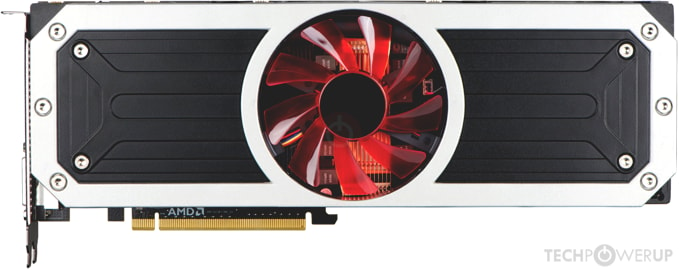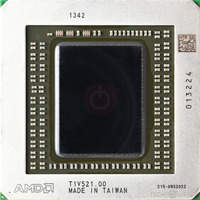Report an Error
AMD Radeon R9 295X2
- Graphics Processor
- Vesuvius x2
- Cores
- 2816 x2
- TMUs
- 176 x2
- ROPs
- 64 x2
- Memory Size
- 4 GB x2
- Memory Type
- GDDR5
- Bus Width
- 512 bit x2
Recommended Gaming Resolutions:
- 1600x900
- 1920x1080
- 2560x1440
The Radeon R9 295X2 was an enthusiast-class graphics card by AMD, launched on April 29th, 2014. Built on the 28 nm process, and based on the Vesuvius graphics processor, in its Vesuvius XT variant, the card supports DirectX 12. This ensures that all modern games will run on Radeon R9 295X2. The Vesuvius graphics processor is a large chip with a die area of 438 mm² and 6,200 million transistors. Radeon R9 295X2 combines two graphics processors to increase performance. It features 2816 shading units, 176 texture mapping units, and 64 ROPs, per GPU. AMD has paired 8 GB GDDR5 memory with the Radeon R9 295X2, which are connected using a 512-bit memory interface per GPU (each GPU manages 4,096 MB). The GPU is operating at a frequency of 1018 MHz, memory is running at 1250 MHz (5 Gbps effective).
Being a dual-slot card, the AMD Radeon R9 295X2 draws power from 2x 8-pin power connectors, with power draw rated at 500 W maximum. Display outputs include: 1x DVI, 4x mini-DisplayPort 1.2. Radeon R9 295X2 is connected to the rest of the system using a PCI-Express 3.0 x16 interface. The card's dimensions are 307 mm x 114 mm x 42 mm, and it features a dual-slot cooling solution. Its price at launch was 1499 US Dollars.
Being a dual-slot card, the AMD Radeon R9 295X2 draws power from 2x 8-pin power connectors, with power draw rated at 500 W maximum. Display outputs include: 1x DVI, 4x mini-DisplayPort 1.2. Radeon R9 295X2 is connected to the rest of the system using a PCI-Express 3.0 x16 interface. The card's dimensions are 307 mm x 114 mm x 42 mm, and it features a dual-slot cooling solution. Its price at launch was 1499 US Dollars.
Graphics Processor
Graphics Card
- Release Date
- Apr 29th, 2014
- Generation
-
Volcanic Islands
(R9 200)
- Predecessor
- Sea Islands
- Successor
- Pirate Islands
- Production
- End-of-life
- Launch Price
- 1,499 USD
- Bus Interface
- PCIe 3.0 x16
- Reviews
- 33 in our database
Relative Performance
Based on TPU review data: "Performance Summary" at 1920x1080, 4K for RTX 3080 and faster.
Clock Speeds
- GPU Clock
- 1018 MHz
- Memory Clock
-
1250 MHz
5 Gbps effective
Memory
- Memory Size
- 4 GB
- Memory Type
- GDDR5
- Memory Bus
- 512 bit
- Bandwidth
- 320.0 GB/s
Render Config
- Shading Units
- 2816
- TMUs
- 176
- ROPs
- 64
- Compute Units
- 44
- L1 Cache
- 16 KB (per CU)
- L2 Cache
- 1024 KB
Theoretical Performance
- Pixel Rate
- 65.15 GPixel/s
- Texture Rate
- 179.2 GTexel/s
- FP32 (float)
- 5.733 TFLOPS
- FP64 (double)
- 716.7 GFLOPS (1:8)
Board Design
- Slot Width
- Dual-slot
- Length
- 307 mm
12.1 inches
- Width
- 114 mm
4.5 inches
- Height
- 42 mm
1.7 inches
- TDP
- 500 W
- Suggested PSU
- 900 W
- Outputs
- 1x DVI
4x mini-DisplayPort 1.2
- Power Connectors
- 2x 8-pin
- Board Number
- 109-C673A7-00D_02
Graphics Features
- DirectX
- 12 (12_0)
- OpenGL
- 4.6
- OpenCL
- 2.1
- Vulkan
- 1.2.170
- Shader Model
- 6.5
Vesuvius GPU Notes
| Generation: Volcanic Islands Desktop Variant: Hawaii / Grenada Graphics/Compute: GFX7 (gfx701) Display Core Engine: 8.5 Unified Video Decoder: 4.2 Video Compression Engine: 2.0 System DMA: 1.0.0 CLRX: GCN 1.1.0 Latest Drivers: Windows Vista : Catalyst Software Suite 13.12 Windows 7: 32-bit: Radeon Software: Adrenalin Edition 18.9.3 64-bit: AMD Software: Adrenalin Edition 22.6.1 Windows 8: Catalyst Software Suite 14.4 Windows 8.1: 32-bit: Radeon Software: Crimson ReLive Edition 16.12.2 / 17.1.2 64-bit: Radeon Software: Crimson ReLive Edition 17.4.4 / 17.7.1 Windows 10: 32-bit: Radeon Software: Adrenalin Edition 18.9.3 64-bit: AMD Software: Adrenalin Edition 22.6.1 |
Retail boards based on this design (13)
| Name | GPU Clock | Memory Clock | Other Changes |
|---|---|---|---|
| 1018 MHz | 1250 MHz | ||
| 1018 MHz | 1250 MHz | ||
| 1018 MHz | 1250 MHz | ||
| 1018 MHz | 1250 MHz | ||
| 1018 MHz | 1250 MHz | ||
| 1018 MHz | 1250 MHz | ||
| 1018 MHz | 1250 MHz | ||
| 1018 MHz | 1250 MHz | ||
| 1018 MHz | 1250 MHz | ||
| 1030 MHz | 1300 MHz | ||
| 1018 MHz | 1250 MHz | Single-slot | |
| 1018 MHz | 1250 MHz | ||
| 1018 MHz | 1250 MHz |
Aug 2nd, 2025 06:00 CDT
change timezone
Latest GPU Drivers
New Forum Posts
- STAR CITIZEN - RSI POLARIS Project (51)
- Free Games Thread (4839)
- memory used for store firmware in adapters wifi usb (6)
- Weird issue with Worms: Armageddon on NV GPUs (11)
- Question about Intel Optane SSDs (91)
- Windows 12 (245)
- My UPS keep sending alarm when I game (39)
- What are you playing? (24030)
- What's your latest tech purchase? (24429)
- HELP (0)
Popular Reviews
- ASUS ROG Crosshair X870E Apex Review
- MSI Claw 8 AI+ A2VM Review
- Montech X5 Review
- Orbital Pathfinder Review
- Herman Miller Logitech G Embody Review - No Pain, No Gain
- Lenovo Legion 5i (15IRX10) Review - Feature-Rich and Wallet Friendly
- Lian Li HydroShift II LCD-C 360TL Review
- Upcoming Hardware Launches 2025 (Updated May 2025)
- Noctua NF-A12x25 G2 PWM Fan Review
- Lian Li O11 Dynamic Mini V2 Review
TPU on YouTube
Controversial News Posts
- AMD's Upcoming UDNA / RDNA 5 GPU Could Feature 96 CUs and 384-bit Memory Bus (138)
- AMD Radeon RX 9070 XT Gains 9% Performance at 1440p with Latest Driver, Beats RTX 5070 Ti (131)
- Intel "Nova Lake-S" Core Ultra 3, Ultra 5, Ultra 7, and Ultra 9 Core Configurations Surface (110)
- DDR6 Memory Arrives in 2027 with 8,800-17,600 MT/s Speeds (102)
- NVIDIA to Debut GeForce RTX 50-series SUPER GPUs by Christmas (101)
- AMD Sampling Next-Gen Ryzen Desktop "Medusa Ridge," Sees Incremental IPC Upgrade, New cIOD (97)
- Intel CEO Confirms SMT To Return to Future CPUs (95)
- NVIDIA Becomes First Company Ever to Hit $4 Trillion Market-Cap (94)




















